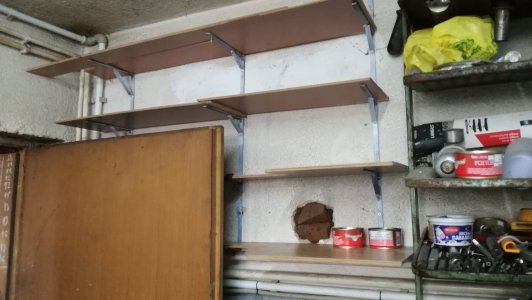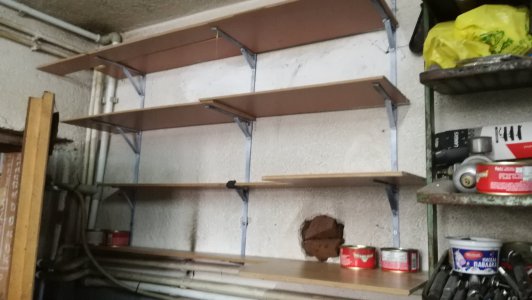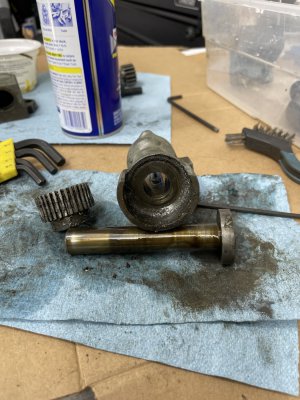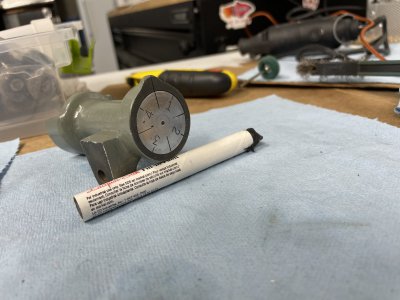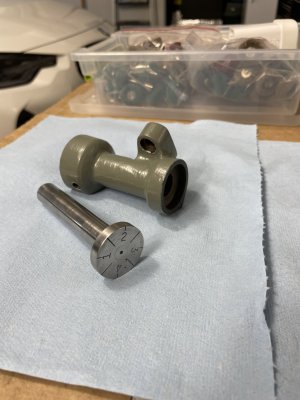-
Welcome back Guest! Did you know you can mentor other members here at H-M? If not, please check out our Relaunch of Hobby Machinist Mentoring Program!
You are using an out of date browser. It may not display this or other websites correctly.
You should upgrade or use an alternative browser.
You should upgrade or use an alternative browser.
POTD- PROJECT OF THE DAY: What Did You Make In Your Shop Today?
- Thread starter wachuko
- Start date
Mike that looks great! Beats the heck out of loading pookie (RTV) in the seams.My son came up over the weekend, and we worked some more on the new engine for his Galaxie. The block had been decked, and between that and normal valve cover sealing surface mismatch between the aftermarket intake and cylinder head combination some adjustment was required. I can't off hand think of any other engine other than these FE's where the intake makes up what would normally be part of the cylinder head. Generally you would remove material from the intake port faces to make corrections, but the head and intake ports lined up fine and the setup for milling the valve cover rails was much easier, and no real math required. Nodded the head to 32deg and took .046 off one side, flipped the setup and took .070 off the other. Pay no attention to the jinky setup, it was actually very solid, and everything came out quite nicely. Was good to be working with my son again, and he will be back over Thanksgiving to hopefully get it buttoned up and back in the car. The last pic was the mismatch before being cut. Cheers, Mike
View attachment 456348View attachment 456349View attachment 456350View attachment 456351View attachment 456352View attachment 456353
- Joined
- Jan 2, 2019
- Messages
- 6,519
Back when I decided I needed a mill and started building one the goal was to make/modify motorcycle parts. Well, four machines later and onto the second bike project I was doing just that.
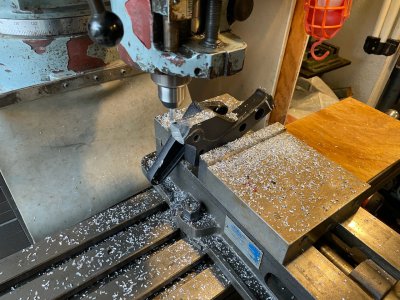
This is a piece to hold one side of the motor for my power train swap on my 2010 Zero DS. Sure is nice to work at a place where I can just cut pieces off a scrap frame rather than building them by hand.
John

This is a piece to hold one side of the motor for my power train swap on my 2010 Zero DS. Sure is nice to work at a place where I can just cut pieces off a scrap frame rather than building them by hand.
John
- Joined
- Jul 14, 2017
- Messages
- 2,446
- Joined
- Sep 2, 2013
- Messages
- 5,098
While they can be great engines performance wise, and had many wins in Cobras, and the GT-40's at Le mans the head/intake issue can be a pain. It is exacerbated by the fact that the valve covers have only five bolts, with two on the bottom rail and three on the top. Must have been a Friday in the engineering department when they came up with that one. I've built several of these, and they can be made to be oil tight, but it takes some attention to detail. I guess you have to remember that these engines were being designed in the mid fifties and came out in 58 when overhead valve V8's where still fairly new to the scene. Mike
Seems like that kind of setup is just begging for leaks as gaskets compress?
But wait Mike! I thought the strategy was that if they didn't leak that meant they were out of oil? Tin can valve covers, two part rear main seals (think infused cord here), and timing chain covers sealed with cork. Yes sir, it sure did take a lot of attention to detail to keep them dry.While they can be great engines performance wise, and had many wins in Cobras, and the GT-40's at Le mans the head/intake issue can be a pain. It is exacerbated by the fact that the valve covers have only five bolts, with two on the bottom rail and three on the top. Must have been a Friday in the engineering department when they came up with that one. I've built several of these, and they can be made to be oil tight, but it takes some attention to detail. I guess you have to remember that these engines were being designed in the mid fifties and came out in 58 when overhead valve V8's where still fairly new to the scene. Mike
We've come a long way............. in some ways anyway.
- Joined
- Jan 4, 2021
- Messages
- 1,783
Those were the days: never had to change the oil, just add a quart every month (or so).But wait Mike! I thought the strategy was that if they didn't leak that meant they were out of oil? Tin can valve covers, two part rear main seals (think infused cord here), and timing chain covers sealed with cork. Yes sir, it sure did take a lot of attention to detail to keep them dry.
We've come a long way............. in some ways anyway.
- Joined
- Jun 12, 2014
- Messages
- 4,808
I have not been very happy when using my scissor type knurlers, tightening the scissor's nut is always a PTA and dangerous as any wrench is close to the spinning chuck. One could use a deep socket and a ratchet or something like that but kind of funky, so I decided to make an extended nut out of some scrap 1045 I had on hand and added some handles.
I turned two arms out of 0.5" O1 rod, and then cut some 1.5" 6061 aluminum rod to make the handle balls. I have been power tapping with my lathe tailstock tapping clutch, it continues to work very well, and prevents the tap handles form crashing into my cross slide when the tap bottoms out. I have done a number of 1/4" through 1/2" power tapping in steel and aluminum and tapping clutch system has worked very consistently. I dial up the tension for the coarser threads, and using spiral traps allows me to power tap deep threads in a single pass. Conventional hand taps would typically take multiple passes to clear the chips, and since I mostly tap into blind holes the spiral body taps work better in this applications.

 www.hobby-machinist.com
Tapping 1/2-20 for handle balls
www.hobby-machinist.com
Tapping 1/2-20 for handle balls
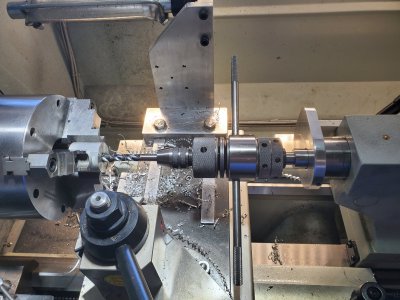
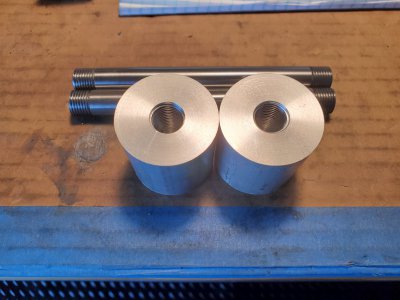
Turned two 1.5" balls using my ball turner.
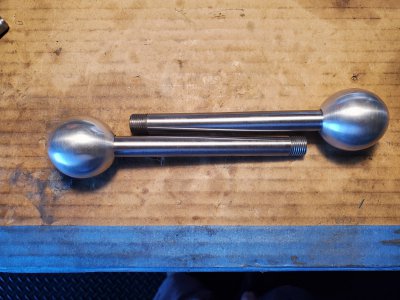
Next I turned the extended nut body, power tapped a 3/8-16 thread the fist inch from the small diameter end, and then rounded it so its fits into a cupped area in the knurler scissor jack.
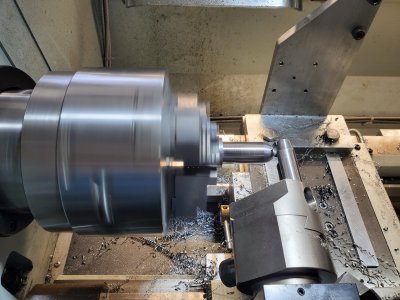
I beveled the top of the nut body at a 15 degree angle for the handles, mounted the body in a square 5C block and tapped both handle holes on the mill. I use a digital inclinometer to set the angles.
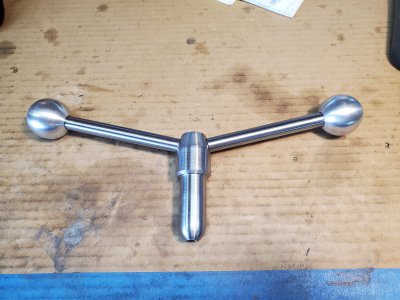
Original knurler with nut, and new extended body nut with handles.
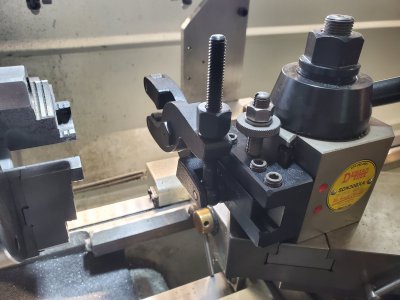
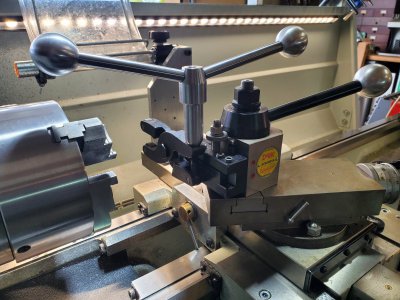
Much happier now.
I turned two arms out of 0.5" O1 rod, and then cut some 1.5" 6061 aluminum rod to make the handle balls. I have been power tapping with my lathe tailstock tapping clutch, it continues to work very well, and prevents the tap handles form crashing into my cross slide when the tap bottoms out. I have done a number of 1/4" through 1/2" power tapping in steel and aluminum and tapping clutch system has worked very consistently. I dial up the tension for the coarser threads, and using spiral traps allows me to power tap deep threads in a single pass. Conventional hand taps would typically take multiple passes to clear the chips, and since I mostly tap into blind holes the spiral body taps work better in this applications.

Lathe Tailstock Tapping Clutch
I was thinking of making some form of tapping and die clutch system for the tailstock in my lathe, where one can adjust the tapping tension so it would release at a given tension. Quite often one is either tapping either under power into a blind hole and when you get to the bottom of the hole it...
 www.hobby-machinist.com
www.hobby-machinist.com


Turned two 1.5" balls using my ball turner.

Next I turned the extended nut body, power tapped a 3/8-16 thread the fist inch from the small diameter end, and then rounded it so its fits into a cupped area in the knurler scissor jack.

I beveled the top of the nut body at a 15 degree angle for the handles, mounted the body in a square 5C block and tapped both handle holes on the mill. I use a digital inclinometer to set the angles.

Original knurler with nut, and new extended body nut with handles.


Much happier now.

- Joined
- Mar 22, 2022
- Messages
- 340


